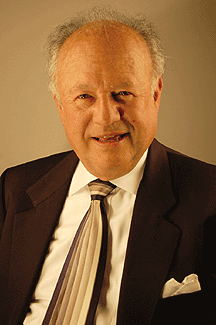The Importance Of Pattern Recognition
Henry "Hank" Pruden: What The Future Holds
by Jayanthi Gopalakrishnan
Henry "Hank" Pruden is a leading technical analyst with more than
20 years of active trading experience. Currently, he is the executive director
of the Institute of Technical Market Analysis and president of the Technical
Securities Analysts Association of San Francisco. Pruden is also a professor
at Golden Gate University in San Francisco, where he has taught technical
analysis for 30 years. He has also served on the board of directors of
the Market Technicians Association and serves as vice chair of the Americas
for the International Federation of Technical Analysts. Technical Analysis
of STOCKS & COMMODITIES Editor Jayanthi Gopalakrishnan spoke with Pruden
on June 29, 2007.

What attracted me can
be summarized under my notions of Wyckoff the man,
Wyckoff the method, and
Wyckoff the mystique.
Hank, why don't you start by telling us how you got interested in the Wyckoff method.
What attracted me to the Wyckoff method can be summarized under my notions of Wyckoff the man, Wyckoff the method, and Wyckoff the mystique. An excellent article written by David Penn and published in your magazine a few years ago had a profile of Richard Wyckoff, and it was well done. I really thought he was an outstanding character in the history of technical analysis thinking. So early on I was attracted to Wyckoff. I thought he was a careful and responsible individual, in terms of taking the best practices on Wall Street and codifying them, as he said, to make up "the real rules of the game."
There was another element that attracted me to the Wyckoff method. I had a friend who was an engineer with an airline in Lebanon before the conflict drove him and his family out of there. As an engineer, he found the Wyckoff method to be a solid methodology and he used it effectively. That drew me to taking the correspondence course from the Stock Market Institute (SMI) in the late 1970s. That's pretty much what brought me into the method. I liked the method; it was very systematic. I liked the math, I liked that there were a number of schematics to follow as well as checklists and rules.
What are some examples?
Let's look at the schematics of accumulation. Accumulation patterns can be broken into phases. So you would have a series of decision rules such as what happens at the end of a trading range. I like that systematic balance between the pictures and the checklists. It is not simply flying by the seat of your pants, and it isn't simply a case whereby you might try to identify an overall pattern, put a label on it, and make a decision. It was slicker, like the anatomy of a trading range. It made a good deal of sense. But what really did it for me -- and I am going to put it under the category of "Wyckoff the mystique" -- was after I read Reminiscences Of A Stock Operator, I wished that somebody would take all the principles in that book and codify them into some sort of a system I could follow. So when I came across Wyckoff I said, "There's my answer."
That really isn't surprising, since Wyckoff and the author of Reminiscences, Edwin LeFèvre, were contemporaries. They were on Wall Street at the same time. They probably talked to the same individuals.
The final factor is the notion of the composite man, or composite operator.
And what is that?
That is when you diagnose charts and you're asking yourself, "What are the motives of the smart money behind the scenes?" With that sort of thinking, you are trying to follow in the footsteps of the smart money. I thought that was an empowering thing with the Wyckoff method.
So these are the sorts of things that attracted me to Wyckoff. The method, of course, was broken down into five steps. Then there are the schematics and the checklists, so most of the Wyckoff method we understand really is the method to use. Most important, Wyckoff works. I have seen it work. I have seen it work for other traders in different time frames, and in different vehicles.
When you use the Wyckoff method, do you mostly use it for active trading or for longer-term trading?
Well, I've had a transition from full-time trading to full-time academia.
When I was trading full time my time frames were short, much shorter than
they are now. I traded actively in stock index futures and options, and
when I went into academia I attempted to both teach and trade simultaneously.
Oh, the sleepless nights! I said, "Okay, something has to change."
...Continued in the September 2007 issue of Technical Analysis
of STOCKS & COMMODITIES
Excerpted from an article originally published in the September 2007
issue of Technical Analysis of STOCKS & COMMODITIES magazine. All rights
reserved. © Copyright 2007, Technical Analysis, Inc.
Return to September 2007 Contents